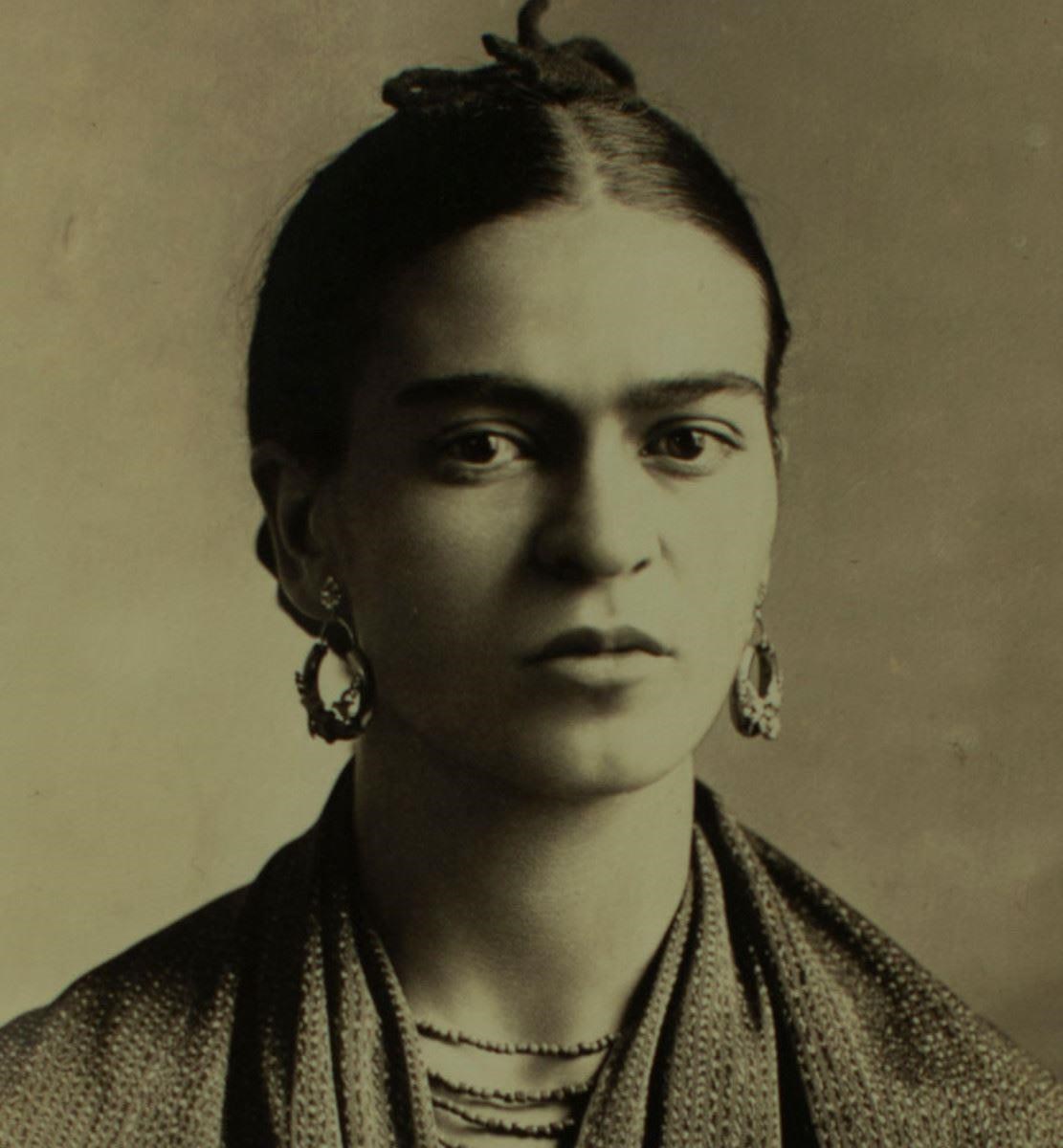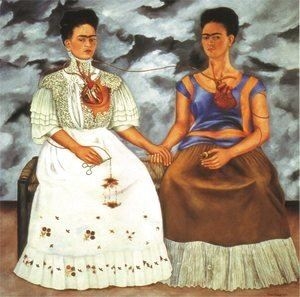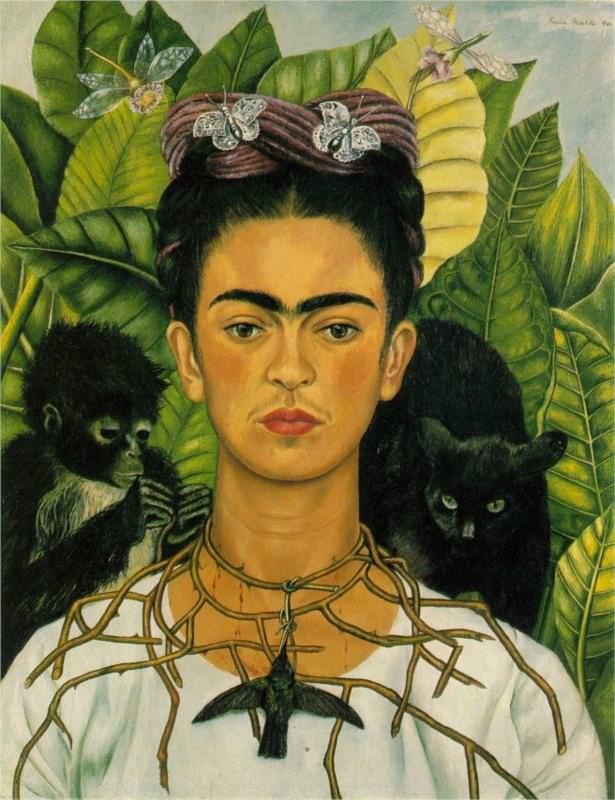 Portrait of Frida Kahlohttps://www.biography.com/people/frida-kahlo-9359496The world which we inhabit is filled with heroes, both fictional and non fictional. They exist in all fields of interests and in all forms. The one thing that they all have in common, though, is their ability to help others for the greater good of humanity. Heroes can be found everywhere, from children to bus drivers. Heroism has always been a necessity in this dark world. Every moment can be seen as an opportunity to make the world a better place, to take control, and to help. In order to be a hero, one must possess perseverance and leadership, or confidence. By confidence, it should be made clear that it does not mean to be proud, but rather, to fight for what one believes in with conviction. They should clearly show that they care for what they fight for and should do so with a passion. A hero is someone who overcomes his own pain and struggles and betters the lives of other people.
Portrait of Frida Kahlohttps://www.biography.com/people/frida-kahlo-9359496The world which we inhabit is filled with heroes, both fictional and non fictional. They exist in all fields of interests and in all forms. The one thing that they all have in common, though, is their ability to help others for the greater good of humanity. Heroes can be found everywhere, from children to bus drivers. Heroism has always been a necessity in this dark world. Every moment can be seen as an opportunity to make the world a better place, to take control, and to help. In order to be a hero, one must possess perseverance and leadership, or confidence. By confidence, it should be made clear that it does not mean to be proud, but rather, to fight for what one believes in with conviction. They should clearly show that they care for what they fight for and should do so with a passion. A hero is someone who overcomes his own pain and struggles and betters the lives of other people.
One particular artist who made her own way into the world by being a revered feminist icon was Frida Kahlo. Frida Kahlo was a bisexual, Mexican surrealist born in 1907, in Coyoacan, Mexico, just before the Mexican revolution. At age seven, she contracted polio, which ruined both of her feet. Despite that, her father encouraged Kahlo to pursue physical activities in order to exercise her legs. As a young woman, she was seen as rebellious through her appearance and mannerisms. She even attended a boy’s school and was introduced into the world of politics there. During that time, she was in a bus accident which severely injured her: an accident which she never fully recovered from. While in her recovery period immediately after the accident, her mother bought her a special type of easel to allow her to paint when on her back. That was the beginning of Kahlo’s artistic journey where she painted away her suffering. In 1929, she married the famous Mexican muralist, Diego Rivera, who led Kahlo deeper into the political realm. The rocky relationship between the two highly impacted Kahlo’s well-being; she even contemplated suicide because of the weight of her struggles. She passed away in 1954 due to a pulmonary embolism. A hero must possess perseverance and a sense of leadership and boldness. They must have a personal conviction to change the world and must try to follow through with it, no matter how unpopular the idea seems. By using her paint to transform her pain into art and boldly leading the way for other women to follow, Frida Kahlo stands as a hero worthy of admiration.
 The Two Fridashttps://www.frida-kahlo-foundation.org/the-complete-works.htmlFrida Kahlo persevered over the hardships in her life, instead of allowing them to block her path to success, making her a truly inspiring hero. Frida Kahlo’s bus accident severely ruined her pelvis and her spine, which she spent many months recovering from: “Kahlo was required to spend long periods of time flat on her back in bed, so her mother bought her a special easel that she could use despite her physical limitations. She began to express her explosive feelings through painting” ("Frida Kahlo"). After Kahlo’s bus accident and being debilitated, she did not wallow in her misery. Rather, she began to create something out of it. Kahlo’s legs were already ruined before because of polio from her childhood. Even with the presence of a second major health issue in her life, she forged on. Despite not exactly being able to lead a “normal” life, she still pursued greater things, like art. Kahlo used her pain to make her better, rather than allow it to tear her down. She came out stronger from her misfortunes, and even used them to blossom into a more complex artist, like with her paintings about miscarriages. Only people like heroes can come out stronger from pain. It takes amounts of strength to not blame the world for issues presented to us. Another time Frida Kahlo demonstrated her determination to overcome hardships was when towards the end of her life in the ‘50s, she began to have more problems moving around on her own feet. Her mental health was on a decline as well as her physical health: “11 February 1954/ They amputated my leg 6 months ago/ It seemed to me/ centuries of torture and/ at times I nearly went crazy. I still feel like committing suicide/ Diego prevents me from doing it in the vain belief that maybe he will need me… But I have never suffered so much in my life. I’ll wait a while… It is already March Springtime 21/ I have achieved a lot. Confidence in walking/ Confidence in painting… My will is strong/ My will remains” (Lowe 278). Kahlo wrote this into her diary herself. Even towards the end of her life, and knowing that her time would come, Kahlo still dedicated her life for others. She lived for them, with the thought that they would need her. Just a month ago, she was struggling for a will to live, but quickly overcame her doubts and pains. She defeated her pain with dedication and clear effort. Perseverance is hard skill for most to obtain. About a month later, Kahlo came back with a new, restored confidence. After being so broken just a month before, Kahlo bounced back again with her iron will, ready to help the world again. One can see the clear change in her entries. It requires discipline and strength to move on and accept the hurdles of life. It is difficult to take the high road and be courageous enough to accept misfortunes, and not just accept them, but to grow from them, which Kahlo always did.
The Two Fridashttps://www.frida-kahlo-foundation.org/the-complete-works.htmlFrida Kahlo persevered over the hardships in her life, instead of allowing them to block her path to success, making her a truly inspiring hero. Frida Kahlo’s bus accident severely ruined her pelvis and her spine, which she spent many months recovering from: “Kahlo was required to spend long periods of time flat on her back in bed, so her mother bought her a special easel that she could use despite her physical limitations. She began to express her explosive feelings through painting” ("Frida Kahlo"). After Kahlo’s bus accident and being debilitated, she did not wallow in her misery. Rather, she began to create something out of it. Kahlo’s legs were already ruined before because of polio from her childhood. Even with the presence of a second major health issue in her life, she forged on. Despite not exactly being able to lead a “normal” life, she still pursued greater things, like art. Kahlo used her pain to make her better, rather than allow it to tear her down. She came out stronger from her misfortunes, and even used them to blossom into a more complex artist, like with her paintings about miscarriages. Only people like heroes can come out stronger from pain. It takes amounts of strength to not blame the world for issues presented to us. Another time Frida Kahlo demonstrated her determination to overcome hardships was when towards the end of her life in the ‘50s, she began to have more problems moving around on her own feet. Her mental health was on a decline as well as her physical health: “11 February 1954/ They amputated my leg 6 months ago/ It seemed to me/ centuries of torture and/ at times I nearly went crazy. I still feel like committing suicide/ Diego prevents me from doing it in the vain belief that maybe he will need me… But I have never suffered so much in my life. I’ll wait a while… It is already March Springtime 21/ I have achieved a lot. Confidence in walking/ Confidence in painting… My will is strong/ My will remains” (Lowe 278). Kahlo wrote this into her diary herself. Even towards the end of her life, and knowing that her time would come, Kahlo still dedicated her life for others. She lived for them, with the thought that they would need her. Just a month ago, she was struggling for a will to live, but quickly overcame her doubts and pains. She defeated her pain with dedication and clear effort. Perseverance is hard skill for most to obtain. About a month later, Kahlo came back with a new, restored confidence. After being so broken just a month before, Kahlo bounced back again with her iron will, ready to help the world again. One can see the clear change in her entries. It requires discipline and strength to move on and accept the hurdles of life. It is difficult to take the high road and be courageous enough to accept misfortunes, and not just accept them, but to grow from them, which Kahlo always did.
 Self Portrait with Thorn Necklace and Hummingbirdhttps://www.fridakahlo.org/self-portrait-with-thorn-necklace-and-hummingbird.jsp#prettyPhotoAnother way Frida Kahlo demonstrated heroism was how she paved the way for other women to join her on the journey to equality by being a feminist and breaking gender stereotypes, which truly makes her a figure worthy of admiration. A hundred years ago, life was very different and much less progressive than today. In the last 100 years, there have been great strides towards achieving gender equality in contemporary society. Frida Kahlo was one of those people who influenced this movement greatly. For example, during Kahlo’s time, anything related to a woman’s health was extremely taboo. It was seen as inappropriate and revolting: “After suffering a miscarriage in Detroit and later the death of her mother, Kahlo painted some of her most-harrowing works. In Henry Ford Hospital (1932) Kahlo depicted herself hemorrhaging on a hospital bed amid a barren landscape, and in My Birth (1932) she painted a rather taboo scene of a shrouded woman giving birth” (Zelazko 2018). As an influential female painter, communicating her emotions through art was a large step in the right direction. Instead of being ashamed or projecting feelings of inadequacy out towards the world, she showed the painful truth of having a miscarriage. Kahlo did not shy away from discussing her pains. She was bold enough to lead the way for women to begin talking about these “taboo” scenes. Kahlo was a leader and an unabashed feminist. Another way Frida Kahlo led the way for women was through her resolve to not conform to the standards and stereotypes set by society: “Frida was a rebellious teenager, setting her own style of dress… often appearing in men’s suits… Her dark eyebrows met in the middle and she didn’t bother to pluck them. She also had a faint mustache that she did not hesitate to include in her many self-portraits. She defied convention from the start” (Morrison 16). Kahlo did not enjoy following the rules that society had set for her. Rather, she chose to make her own. Instead of wearing dresses and skirts, she confidently wore suits that were meant for men. Society during Kahlo’s time had had more strict expectations for women. She did not stop for what others thought and did whatever she desired to do. Kahlo challenged expectations, rather than conform which takes a great deal of courage to do. Challenging a standard versus simply going with the norm of conformity is difficult to do. It requires discipline and the confidence to follow through, which many women at the time did not possess. Kahlo stands out compared to the women of her time due to her boldness in her decisions and her willingness to break the stereotypes set for women.
Self Portrait with Thorn Necklace and Hummingbirdhttps://www.fridakahlo.org/self-portrait-with-thorn-necklace-and-hummingbird.jsp#prettyPhotoAnother way Frida Kahlo demonstrated heroism was how she paved the way for other women to join her on the journey to equality by being a feminist and breaking gender stereotypes, which truly makes her a figure worthy of admiration. A hundred years ago, life was very different and much less progressive than today. In the last 100 years, there have been great strides towards achieving gender equality in contemporary society. Frida Kahlo was one of those people who influenced this movement greatly. For example, during Kahlo’s time, anything related to a woman’s health was extremely taboo. It was seen as inappropriate and revolting: “After suffering a miscarriage in Detroit and later the death of her mother, Kahlo painted some of her most-harrowing works. In Henry Ford Hospital (1932) Kahlo depicted herself hemorrhaging on a hospital bed amid a barren landscape, and in My Birth (1932) she painted a rather taboo scene of a shrouded woman giving birth” (Zelazko 2018). As an influential female painter, communicating her emotions through art was a large step in the right direction. Instead of being ashamed or projecting feelings of inadequacy out towards the world, she showed the painful truth of having a miscarriage. Kahlo did not shy away from discussing her pains. She was bold enough to lead the way for women to begin talking about these “taboo” scenes. Kahlo was a leader and an unabashed feminist. Another way Frida Kahlo led the way for women was through her resolve to not conform to the standards and stereotypes set by society: “Frida was a rebellious teenager, setting her own style of dress… often appearing in men’s suits… Her dark eyebrows met in the middle and she didn’t bother to pluck them. She also had a faint mustache that she did not hesitate to include in her many self-portraits. She defied convention from the start” (Morrison 16). Kahlo did not enjoy following the rules that society had set for her. Rather, she chose to make her own. Instead of wearing dresses and skirts, she confidently wore suits that were meant for men. Society during Kahlo’s time had had more strict expectations for women. She did not stop for what others thought and did whatever she desired to do. Kahlo challenged expectations, rather than conform which takes a great deal of courage to do. Challenging a standard versus simply going with the norm of conformity is difficult to do. It requires discipline and the confidence to follow through, which many women at the time did not possess. Kahlo stands out compared to the women of her time due to her boldness in her decisions and her willingness to break the stereotypes set for women.
Frida Kahlo’s passion to overcome her obstacles and to aid women in their journey to defy stereotypes by making a lasting impact on our world makes her a truly inspiring figure. Her determination to come out on top despite her severe circumstances demonstrated Kahlo’s tough mentality. In her era, especially, women were treated as less than men, but even in the male dominated field, Kahlo asserted her position as a famed artist. When I was younger and first saw Frida Kahlo’s face, I was surprised by her iconic unibrow. I wondered how her appearance did not bother her; surely she was mocked for it. That was when I began to understand her. Her unibrow was a choice that she was very aware of. It symbolized Kahlo’s boldness. She was not afraid of the opinions of others, because she was strong. Kahlo had a confidence that I desired to have myself. In my head, someone who was confident could rule the world. She broke societal expectations, just by simply being her true self. Not caring for the opinions of others had empowered me as a child, and continues to do so today. Kahlo was a beacon of hope for people during their times of need. She led the way for other women in the world to be empowered by their decisions as she was herself. Kahlo had a progressive mindset which guided us to where we are today as a society. Only those who fight for what they believe in with an open heart and mind to change the world are true heroes. Kahlo being a surrealist not only brought our world to life, but another world as well. She opened the perspectives of people in her time and even to this day is regarded as an icon in the feminist movement. Her boldness in her choices was reflected in everything she did, from her way of dressing to her speech and her art. Her passion and commitment to the art she created along with her drive to create and make the world better for other people displays Frida Kahlo’s true heroism.
Works Cited
"Frida Kahlo." Dictionary of Hispanic Biography, Gale, 1996. Biography In Context, https://link.galegroup.com/apps/doc/K1611000220/BIC?u=powa9245&sid=BIC&xid=a0c6385c. Accessed 12 Apr. 2018.
Kahlo, Frida, and Sarah M. Lowe. The Diary of Frida Kahlo: an Intimate Self-Portrait. Harry N. Abrams, 2006.
Morrison, John, and Jamie Pietras. Frida Kahlo. Chelsea House Publishers, 2010.
Zelazko, Alicja. “Frida Kahlo.” Encyclopædia Britannica, Encyclopædia Britannica, Inc., 25 Jan. 2018, www.britannica.com/biography/Frida-Kahlo.
Page created on 5/28/2018 9:29:29 PM
Last edited 8/2/2018 11:34:20 PM
